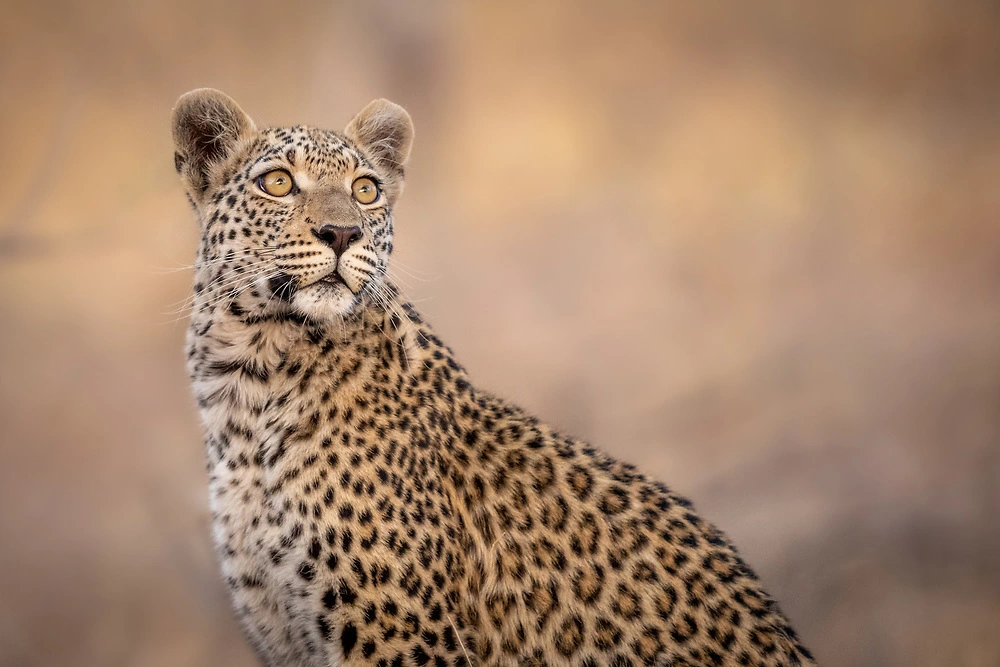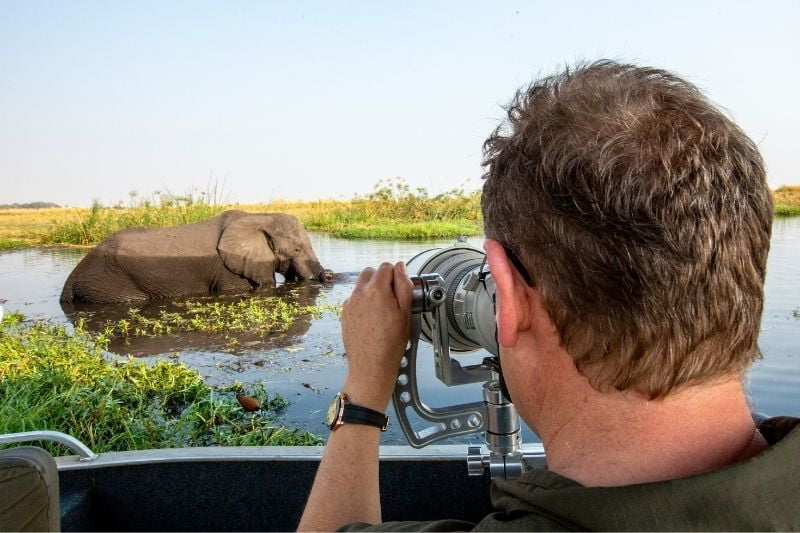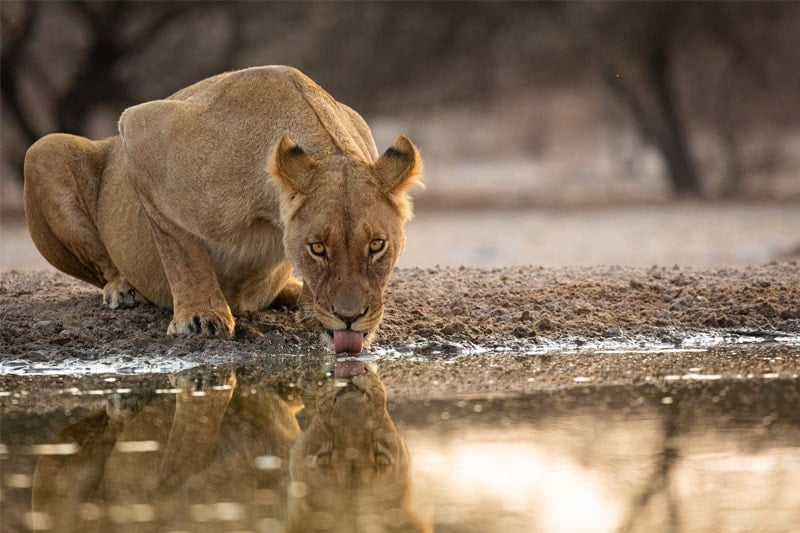The African Jacana
The African Jacana
The Lily Trotter from Planet Earth 3 Freshwater Episode
Capturing an African Jacana (sometimes called a Lily Trotter) walking amongst the water lilies is a firm favourite for our Pangolin guests on the Chobe River. With good reason, these beautiful dark brown birds are extremely photogenic! Watching them traverse at great speed over the lily pads with their unique long legs and long toes is quite the spectacle. Not to mention seeing them in prime parental care mode with their young chicks. In this blog, we will discuss all you need to know about the African Jacana and how to photograph them.

African Jacana and young chick crossing a lily pad. © Sabine Stols
How to identify the African Jacana
The African jacana (actophilornis africanus) is what is known as a wading bird and is spread across Asia, Africa, South and Central America, and Australia. They are easily identifiable with their extremely thin and long toes, which enable them to distribute their weight evenly, allowing them to easily walk across lily pads and other floating vegetation.
Is there a difference between the male and female African Jacana?
The adult male and female African jacana are fairly similar in looks, however, the female is generally larger in size and weight. Their main characteristics are their long necks, elongated legs, short tails and medium-sized egg shape body. They are predominantly rufous brown across their body, however, below their wings are generally a darker brown.
The neck and head are white with a prominent black stripe over their eye and black primary flight feathers. Their chest morphs from white to a pale yellow to orange colour. Their short blue bill continues as a frontal shield extending above the eye stripe, over the face and forehead to the crown. Lastly, their legs and feet are grey with long slim toes and claws. All these elements come together to help easily identify both males and females.

African Jacana checking for food in a lily. © Janine Krayer
Can the Africana Jacana fly well?
Jacanas happen to be quite weak fliers and usually only fly for short distances. The African Jacana molt all of their wing feathers at the same time. This means that this species is unable to fly until its new feathers have grown in. It is very important for the African jacana to keep their feathers clean as this helps them keep light and warm.

Ready for take-off on the Chobe River. © Danielle Carstens
Does the African Jacana have a specific sound?
Some would say that the African Jacana Actophilornis Africanus is quite the noisy bird! They have quite the selection of raucous calls that almost come across as shrieks and barking noises. In flight, they have a loud and fast call of ‘kreep – kreep – kreep’ and for more distinct alarm calls they issue an extremely loud, consistent and sharp single note ‘kaakup’.
Quite the interesting audio element!
African Jacana Adult Call. © Tony Archer
Lesser Jacana – how do they differ?
The African Jacana is one of two jacanas found here in Africa. The Lesser Jacana is smaller and shyer. There is not too much competition between these two species and this is mainly due to their size difference. For example, the Lesser hunts on plant matter that wouldn’t be able to support the weight of the African jacana.

Lesser Jacana on the Chobe River. © Charl Stols
Breeding habits of the African Jacana
Actophilornis africanus are polyandrous, meaning that a single female will mate with multiple males. To attract her, a male must lure her in with his impressive nest-building skills. The African Jacana male is also responsible for the parental care of the chicks (from eggs to young).
Females will mate with males but as soon she has laid the eggs, will move on to another mate. So the female jacana will have access to several males and defend her territories against other females. Leaving males to incubate and raise the chicks.

African Jacana Eggs. © Sabine Stols
On average, 4 eggs are laid in a floating nest. The male will incubate the eggs for approximately 25 days, with the chicks fledging about 50 days later. During the first few weeks of the young finding their feet, the male species have specifically adapted wings to carry the little ones and keep them warm and dry – often giving the illusion of extra legs! The same adaption is used for the jacana eggs in case the nest gets wet.

Male African Jacana carrying chicks. © Charl Stols
When is the best time to see Jacana chicks?
While the jacana’s nest all year round, the best time to spot the chicks would be between March and June when they can be seen among the flowering water lilies and floating vegetation. Trust us when we say it is quite something to see the chicks scoot under the parent bird, as he sweeps them up and carries them off over the aquatic vegetation, tiny legs dangling from under the male African Jacana to avoid predators.

A young African Jacana testing the ‘ground’ on the Chobe River. © Charl Stols
What do Jacanas eat?
The African jacana generally forages along floating vegetation trying to catch flying insects. While they will occasionally choose seeds, due to their preferred habitat, these water birds will often go for small crabs, freshwater insects and larvae, spiders, and molluscs. While the jacana is able to swim underwater, they prefer to walk amongst the shallow lakes, large floating leaves and especially lily pads to find their food.

African Jacana chick with small insect. © Charl Stols
How long do African Jacanas live?
Unfortunately, there is little data available on the life span of the African jacana, but it is thought to be between five and ten years.
Distribution of African Jacanas
Jacanas are found worldwide within the tropical zone. The African jacana actophilornis africanus reach far across the freshwater wetlands of sub-Saharan Africa. They move from west to east and down south reaching as far as South Africa.
In terms of Southern Africa, they are found across Zimbabwe, Mozambique, northern Namibia, and northern Botswana. In South Africa, African Jacana are abundant in the eastern parts and less common in the rest of the country. Their preferred habitat avoids arid areas as well as jungles and forests opting for permanent wetlands. As noted by birdlife international, these species are evaluated as least concern when it comes to the red list category on extinction.

African Jacana with reflection on the Chobe River. © Janine Krayer
What does the word Jacana mean?
Merriam-Webster defines the word Jacana as “any of a family (Jacanidae) of long-legged and long-toed tropical wading birds that frequent coastal freshwater marshes and ponds”. These birds are often nicknamed “lily-trotters” for their ability to walk on floating plants.
A personal favourite though is their Jamaican nickname where they are known as “Jesus birds” because they are seen to be walking on water – legs and enormous feet.
How to photograph African Jacanas
Curious about how to photograph the beautiful African Jacana? Watch this video where Pangolin Photo Safaris Co-Founder Guts demonstrates different ways of photographing one of his favourite subjects. He will explain his settings and techniques to capture this beautiful bird on camera.
Is the African Jacana a migratory bird?
The African jacana species are non-migratory. That being said, they are highly nomadic and will often move in search of new temporary wetlands if need be.

Young African Jacana crossing the water. © Sabine Stols
What other species of Jacana are there?
The Jacanidae family consists of eight species. They are the lesser jacana, the African jacana, the Madagascar jacana, the northern jacana, comb-crested jacana, the bronze-winged jacana, the pheasant-tailed jacana, and the wattled jacana.
Location Key:
Africa: African Jacana, Madagascar Jacana and Lesser Jacana
Asia: Pheasant-tailed Jacana, Comb-crested Jacana and Bronze-winged Jacana
Australia/Oceania: Comb-crested Jacana
North/Central America: Wattled Jacana and Northern Jacana
South America: Wattled Jacana
In conclusion
As you can see there is a lot to be said for these beautiful Jacana’s and why our photo hosts absolutely love photographing them. Now that you’re all clued up on one of our favourite birds to see on the Chobe, why not come and take a look for yourself? Check out more about our safaris below.




Leave A Comment
You must be logged in to post a comment.